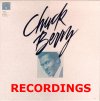
When Chuck Berry started recording in 1955, recording was done in Mono (although Bill Putnam tells that even in the early 1950s they cut some non-Berry takes secretly on two-track stereo tape [“A THIRTY-FIVE YEAR HISTORY AND EVOLUTION OF THE RECORDING STUDIO”, Milton T. Putnam,
http://www.aes.org/aeshc/pdf/putnam_history-of-recording-studios.pdf]).
When Jack Wiener in 1957 built the famous Sheldon Recording Studios at 2120 South Michigan Av. in Chicago where Berry's most important recordings were made, he had provisions to record in Stereo. However, this “double-mono” system was not intended to create stereo recordings but instead mainly thought of as a secondary backup mono system in case some gear failed.
We do not know if any of Berry's early Chess recordings were recorded in Stereo. What we do know is that at least in February 1960 Stereo finally made it to the recording process. This is because “Diploma For Two”, recorded Feb. 15
th, 1960, is available as a true stereo version which was released in 1967 on a British album (“You Never Can Tell”, Marble Arch MALS-702).
As Remastering and Restoration Engineer Steve Hoffman tells, the Chess studios got a four-track recording machine in 1959. They now started to record everything in both Mono and Stereo concurrently. It was common then to do a dedicated mono mix on one of the four tracks with the other three tracks used by three stereo channels (left, center, right). [
https://forums.stevehoffman.tv/threads/chuck-berry-rock-n-roll-rarities-and-more-rock-n-roll-rarities-info.854690/]
However, Andy McKaie (who for instance created the Berry 4-CD sets on Hip-O Select and won the Grammy award “Best Historical Album” for the 1988 “Chuck Berry — The Chess Box”) is quoted saying,
As far as mono versus stereo goes, it seems that if they recorded something specifically for an album in the '60s it was recorded and mixed in stereo. If recorded for a single, it's a toss-up, and for extended periods of time, they never bothered to do anything but mono mixes. [Some specific non-Berry] '63 sessions [...] were recorded and assembled for an album, but only a mono assembly was done and the multi-tracks are either unmarked in our vault or missing. The running masters from those sessions are even only in mono, whereas I have found running masters from 1959 Howlin' Wolf that are in stereo. Then again, nothing but mono exists from Wolf's Red Rooster in '61, though there's a stereo master for Shake for Me from same session. The inconsistency drives me nuts, too, but I can only issue what we have available to me to issue. Sometimes life is like that. — Chess used to keep a two track running for sessions, even when they were doing multi-track sessions. Sometimes the two track seemed to be in mono, sometimes stereo. Before he died, Ron Malo told me that Chess really didn't care about or understand stereo, so if an engineer or a producer didn't dwell on it, what you got was a tossup. Leonard did the Muddy sessions, except for the concept albums, and according to Ron, he really wasn't interested in stereo - his notion was that he was making a single to sell... [https://forums.stevehoffman.tv/threads/for-steve-stereo-remixes.1192/page-2]
After MCA Records had distributed Chess records (including Berry re-issues) since 1983, the company finally in 1984 bought the Chess/Checker/Cadet catalog from Sugar Hill Records, then owner of the Chess archives (whereas the sale by itself is an interesting story resulting in multiple law suits). In 1985 Steve Hoffman got access to the original four-track master tapes. He used some of these for MCA's “
Rock 'n' Roll Rarities“ (Chess 2-LP set 92521, March 1986) and “
More Rock 'n' Roll Rarities” (Chess LP 9190, August 1986) albums. This resulted in the very first stereo recording by Chuck Berry we know of: “I Got To Find My Baby” originally recorded Feb. 12
th, 1960. One should note, though, that Hoffman was using the original three Stereo tracks to newly mix them to create the two Stereo channels on disk. Thus this is not an original 1960s mix if there ever was one.
Steve Hoffman later said:
I really dislike my stereo remixes on the Chuck Berry discs I did. I was way too "gentle" with them. They needed a lot more compression and general nasty stuff to make them sound like their mono counterparts. At the time, I fell in to the trap that usually gets all "remixers" of old classic stuff: The urge to play God. In other words, to make things sound "better" than the original mixes, and to share with all of you music lovers the way the actual multi-track tapes sound. This (in hindsight) is a mistake, because the multi's are just work parts, and sound way too clean to be of any valid interest or use in any thing other than a historical context. If the real mixes vanish just because they are mono, or sound a bit rough, well, this would be a shame... — I didn't realize this until 1986 when my friend and reissue expert Diana Reid Haig explained to me that the "original mix is THE mix, regardless of how bad it sounds, and that anything else is just playing God". She was right. I've never heard a remix that has the energy, life and as good a "vibe" as the original, mono or stereo. — I love stereo. Don't misunderstand me. Stereo is great. If a song or album was only released in mono, and stereo versions can be created, it's fine with me, as long as the "spirit" of the original mix is kept. [https://forums.stevehoffman.tv/threads/for-steve-stereo-remixes.1192/]
So Hoffman created stereo mixes of songs previously available only in Mono. Remembering the technical difficulties in working with 25-year-old tapes, Steve Hoffman told me:
In the early stereo period (when they got the Ampex 4-track until maybe the end of 1961), the music was recorded using the Ampex Master EQ button on the machine. This took it off the NAB standard and made everything sound screechy. When played back, of course, the screech vanished and with it (so the theory goes) some of the tape hiss as well. Only problem? If you didn't have the exact same machine as the one in the studio during recording, the playback was never right. I had to really consult with many Ampex historians in order to get the right EQ to play back those bad sounding 1/2" tapes.
About the other recordings from these two February 1960 sessions Steve Hoffman told me:
I'm certain that all songs from those sessions were there in 1/2". I chose the songs to put on the Rarities because either feedback from fans or I personally liked them. I wanted the songs that sounded more Chuck Berry-like. I took the 1/2" reels into the studio to listen and picked the songs that way. Didn't have the time or budget to do a complete stereo reduction of all the songs nor the research, since the paperwork was so incomplete and they had NO idea what was on many of the reels.
Even though they still existed in 1985, by today the session tapes are lost, as all of the Chess masters were destroyed in the burning of the Universal tape vaults in 2008.
Some more stereo recordings from 1960 and 1961 have survived on Marble Arch records and on Hoffman's 1986 albums: “Bye Bye Johnny”, “Run Around”, “Down The Road A Piece”, “I'm Talking About You”, “Go Go Go”, an alternate take of “Route 66”, and the 1961 version of “Brown-Eyed Handsome Man”. Contemporary, all these were released in Mono only. The stereo version of “Come On”, which is a different recording than the one on the mono single, has been mixed two times, one during the 1960s for a Marble Arch release, one in 1985 for the
Rarities album.
List of Chuck Berry stereo recordings from 1960/1961:
| Recording Date | Song | Stereo Release | Note |
|---|
| 12.2.1960 | I Got To Find My Baby | Chess CH-9190 | |
| 15.2.1960 | Diploma For Two | Marble Arch MALS-702 | |
| 29.3.1960 | Bye Bye Johnny | Chess CH2-92521 | |
| 29.3.1960 | Run Around | Marble Arch MALS-702 | |
| 12.4.1960 | Down The Road A Piece | Chess CH-9190 | |
| 19.1.1961 | Route 66 (alt. take 11) | Chess CH-9190 | |
| 19.1.1961 | I'm Talking About You | Chess CH-9190 | |
| 3.8.1961 | Come On (alt. take) | Marble Arch MALS-611 | Remix on Chess CH2-92521 |
| 3.8.1961 | Go Go Go | Chess CH-9190 | |
| 3.8.1961 | Brown-Eyed Handsome Man | Chess CH-9190 | |
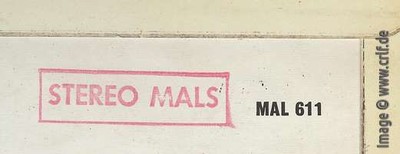
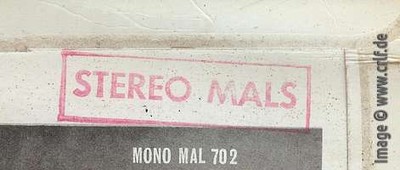
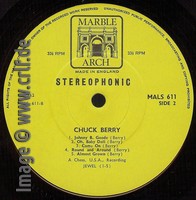
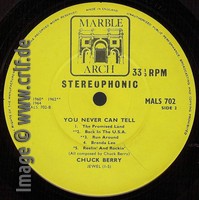
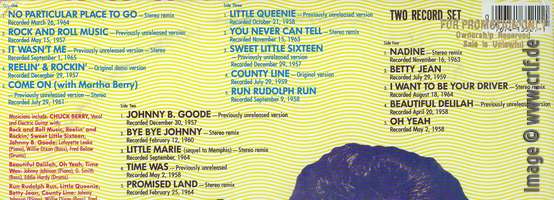
MALS 611 and 702 labels and cover segments, Rarities cover segment
When Berry returned to the recording studio in January 1964, the industry had changed. Stereo recording was now common and albums were sold in stereo versions along with the mono versions (though at a higher price). According to Steve Hoffman, Chess still recorded on four-track tapes, but now used all four tracks to record separated segments of the song (e.g. vocal, guitar, piano and rhythm).
Mono versions of the songs were still needed, though. Since record player cartridges often could not play the stereo records, companies still produced mono albums. And singles were all-mono anyway. Since the original session tape was now multi-tracked, there were two ways to create a mono version: You could take the original multi-track and mix a dedicated mono version like you did with the stereo version. Or you could mix the stereo version first and then combine the two stereo channels into a single mono channel. This is called “folding down the Stereo”. A folded-down stereo results in a release on which the center instruments (which are on both stereo channels) are much louder than the left and right instruments (which are only on one channel). At least for some songs Chess used both techniques. The so-called “UK mix” (on Chess CRL-4005) of “Jamaica Farewell” is a dedicated mono mix, while the “US mix” (on Chess LP-1495) is a fold-down from the stereo mix (with more prominent vocals). The two sound that different, early discographies had them listed as different takes.
Starting from “Nadine”, we find Berry's recordings both as a mono mix or fold-down (on singles and mono albums) and as a stereo mix (on stereo albums). In the US the stereo versions were on the Chess albums numbered with an LPS prefix, while the mono versions were on the Chess albums numbered just with an LP prefix. For instance “His Daughter Caroline” is on “Chuck Berry In London” Chess LP-1495 in Mono and on LPS-1495 in true Stereo; “No Particular Place To Go” is on “St. Louis To Liverpool” Chess LP-1488 in Mono and on LPS-1488 in true Stereo.
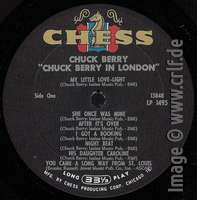
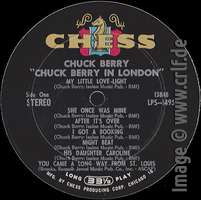
CHESS LP-1495 and CHESS LPS-1495 labels
Note that Steve Hofmann re-mixed “No Particular Place To Go” for the 1986
Rarities album (Chess LP 92521) thus creating a
different Stereo mix. Steve was aware of the original mixes but tried to make it better:
I would have been able to duplicate the original mono or stereo mix of the Chuck Berry stuff. I just didn't WANT to. I wanted to stay far away from the feel of the original mixes; why bother to remix them? I had some cockeyed notion of "revealing" what it must have sounded like in the studio actually recording stuff, before all of those nasty "compromises" like dynamic range compression, detail obscuring echo and tonal enhancing equalization came into the picture. Problem is, as we know, those things actually MAKE the mix special. Oh well. What I mixed sounds to me these days like good pre-mix demo versions. Heh. Better than nothing I guess... — What I don't like, is making a new stereo mix where the original stereo mix works just fine. For what reason do this? Ego, usually. I went down that road. All engineers do. Can't be helped. In all cases (expect one, I guess, Simon & Garfunkel's PSRT), I can spot a remix like a dead skunk: Beloved levels are different, compression is less, or more. Echo is digital or too much, or not enough, EQ is radically changed. In most cases, the mixes sound "modern". Geez I hate that. Usually the hard left/right/center has been changed. [https://forums.stevehoffman.tv/threads/steve-if-you-had-do-re-do-a-cd-which-one-would-it-be.16949/ and https://forums.stevehoffman.tv/threads/for-steve-stereo-remixes.1192/ ]
Where Hoffman had access to the original four-track session tapes, he could rearrange the various instruments to what would become the left and right stereo channels. He did so with all his remixes except for “You Never Can Tell”. A reason may be that on this song Berry's vocal had been overdubbed in the chorus sections of the song. If there was no separate track left for the vocal overdub, the overdubbing was probably done to a final two-track stereo mix. As Hoffman told me:
I liked the original stereo mix and discovered that the stereo ALBUM master was really just a dub with extra echo of the original two-track stereo album mixes (marked "DO NOT USE"). So, of course I used the version with less echo. I think if you will compare you will find that the version I used with less echo is more pleasing to the ear.
On other songs such as “It Wasn't Me”, the remix was done from the original non-overdubbed session tapes, on “Little Marie” the vocal and guitar overdub was obviously on a separate track on the tape as Hoffman moved it around in his remix.
Almost all of Berry's Chess recordings made between 1964 and 1966 exist in true Stereo as well as in mono mixes. The original Chess albums were issued in both Mono and Stereo, the original Chess singles were issued in Mono only.
List of Chuck Berry stereo recordings from 1964 to 1966:
| Recording Date | Song | Mono Release | Stereo Release | Note |
|---|
| 7.1.1964 | Nadine | Chess 1883 | Chess 1883 light-blue re-issue (1970s) | Remix on Chess CH2-92521 |
| 7.1.1964 | You Never Can Tell | Chess LP-1488 | Chess LPS-1488 | “Remix” on Chess CH2-92521 is original mix without the extra echo. |
| 7.1.1964 | The Little Girl From Central | Pye Intl. NPL 28039 | Marble Arch MALS-702 | |
| 7.1.1964 | Things I Used To Do | Chess LP-1488 | Chess LPS-1488 | |
| 7.1.1964 | Fraulein | Pye Intl. NPL 28031 | MCA MCD-30487 (1993) | |
| 7.1.1964 | Lonely All The Time | Pye Intl. NPL 28031 | Chess CH6-80001 (1988) | |
| 7.1.1964 | O Rangutang | Chess 1883 | n.a. | |
| 20.2.1964 | Big Ben Blues | Pye Intl. NPL 28039 | Marble Arch MALS-702 | |
| 20.2.1964 | The Promised Land | Chess LP-1488 | Chess LPS-1488 | Remix on Chess CH2-92521 |
| 20.2.1964 | Brenda Lee | Chess LP-1488 | n.a. | The Stereo mix on Chess LPS-1488 is the Mono master with defects on the two Stereo channels. |
| 26.3.1964 | No Particular Place To Go | Chess LP-1488 | Chess LPS-1488 | Remix on Chess CH2-92521 |
| 26.3.1964 | You Two | Chess LP-1488 | Chess LPS-1488 | |
| 26.3.1964 | Liverpool Drive | Checker LP-2991 | Checker LPS-2991 | |
| 4.1964 | Chuck's Beat | Checker LP-2991 | Checker LPS-2991 | |
| 4.1964 | Bo's Beat | Checker LP-2991 | Checker LPS-2991 | |
| 16.8.1964 | Little Marie | Chess LP-1488 | Chess LPS-1488 | Remix on Chess CH2-92521 |
| 16.8.1964 | Go, Bobby Soxer | Chess LP-1488 | Chess LPS-1488 | |
| 16.12.1964 | Lonely School Days | Chess 1926 | n.a. | |
| 16.12.1964 | His Daughter Caroline | Chess LP-1495 | Chess LPS-1495 | |
| 16.12.1964 | Dear Dad | Chess LP-1495 | Chess LPS-1495 | |
| 16.12.1964 | I Want To Be Your Driver | Chess LP-1495 | Chess LPS-1495 | Remix on Chess CH2-92521 |
| 16.12.1964 | The Song Of My Love | Chess LP-1495 | Chess LPS-1495 | |
| 16.12.1964 | Butterscotch | Chess LP-1495 | Chess LPS-1495 | |
| 9.1.1965 | After It's Over | Chess LP-1495 | Chess LPS-1495 | |
| 9.1.1965 | Why Should We End This Way | Chess LP-1495 | Chess LPS-1495 | |
| 9.1.1965 | You Came A Long Way From St. Louis | Chess LP-1495 | Chess LPS-1495 | |
| 9.1.1965 | She Once Was Mine | Chess LP-1495 | Chess LPS-1495 | mono is faded earlier |
| 9.1.1965 | Jamaica Farewell | Chess CRL-4005 | Chess LPS-1495 | mono versions are faded, mono on Chess LP-1495 is a fold-down of the stereo version |
| 31.1.1965 | My Little Love-Light | Chess LP-1495 | Chess LPS-1495 | |
| 31.1.1965 | I Got A Booking | Chess LP-1495 | Chess LPS-1495 | |
| 31.1.1965 | St. Louis Blues | Chess LP-1495 | Chess LPS-1495 | |
| 1.9.1965 | Run Joe | Chess LP-1498 | Chess LPS-1498 | |
| 1.9.1965 | It's My Own Business | Chess LP-1498 | Chess LPS-1498 | |
| 1.9.1965 | One For My Baby | Chess LP-1498 | Chess LPS-1498 | |
| 1.9.1965 | Every Day We Rock & Roll | Chess LP-1498 | Chess LPS-1498 | |
| 1.9.1965 | My Mustang Ford | Chess LP-1498 | Chess LPS-1498 | Remix on Chess CH-9190 |
| 2.9.1965 | Merrily We Rock & Roll | Chess LP-1498 | Chess LPS-1498 | |
| 2.9.1965 | Vaya Con Dios | Chess LP-1498 | Chess LPS-1498 | |
| 2.9.1965 | Wee Hour Blues | Chess LP-1498 | Chess LPS-1498 | |
| 3.9.1965 | It Wasn't Me | Chess LP-1498 | Chess LPS-1498 | Remix on Chess CH2-92521 is of original recording without overdubs |
| 3.9.1965 | Ain't That Just Like A Woman | Chess LP-1498 | Chess LPS-1498 | Remix on Chess CH-9190 |
| 3.9.1965 | Right Off Rampart Street | Chess LP-1498 | Chess LPS-1498 | |
| 3.9.1965 | Welcome Back, Pretty Baby | Chess LP-1498 | Chess LPS-1498 | |
| 3.9.1965 | Sad Day — Long Night | Chess CRL-4506 | Chess CH6-80001 (1988) | |
| 13.4.1966 | Ramona, Say Yes | Chess 1963 | n.a. | Stereo Mix on Chess CH6-80001 is of original recording without overdubs |
| 13.4.1966 | Viva Rock & Roll | n.a. | Chess CH-50008 (1971) | |
| 13.4.1966 | Lonely School Days | Chess 1963 | Chess CH-50008 (1971) | |
(Those studio recordings from this period which were first released on the HIP-O Select and Bear Family boxes are omitted from this list as they are only available in Stereo.)
In 1967 when Mercury released their first Chuck Berry album, discussions in the industry had been heated. The companies wanted to get rid of the additional effort to create both stereo and mono versions of the same album. Most of the record players were now able to play mono and stereo records alike. However, record buyers did not necessarily know and were still asking for the cheaper mono albums.
Mercury was among the first companies to play a simple trick on their customers: They pressed stereo albums only but placed some of them in a jacket claiming Mono. Therefore Chuck Berry's first Mercury album “Golden Hits” (1967) came in two different sleeves: Mercury MG-21103 claims to be Mono, Mercury SR-61103 claims to be Stereo. Both jackets however contained the exact same disk etched “2/61103 A/B” (later pressings had just “SR-61103” in multiple variations). According to Thierry Chanu, “Golden Hits” was issued in Mono only in France (Mercury 124.033 MDL).


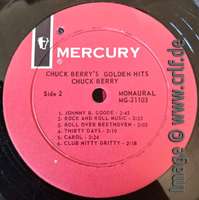


Mercury MG-21103 and SR-61103 labels and cover segments and the deadwax etching which is identical on both
Note that one track on Mercury MG-21103/SR-61103 is not a true stereo version. “Club Nitty Gritty” had been mixed to Mono for the 1966 single release. Instead of using/mixing a true stereo version for the album release, Mercury “electronically reprocessed for stereo” this track. ERS was a technique used in the 1960s to make mono recordings (such as Berry's early Chess takes) sound like stereo. To do so, the original mono signal was copied to both stereo channels. On one channel the higher tones were enhanced, on the other the lower tones. One channel was delayed a tiny fraction of a second and artificial echo and reverb were used to mask this delay. Unfortunately this distorts the original recording to an amount which makes them sound ugly when compared to the original mono mix. Most of Berry's mono recordings also exist in an “electronically altered for stereo” variant, but that's not our topic here. The interesting part is that a true stereo version of “Club Nitty Gritty” has never been released (which in turn opens room for discussions about whether this recording was done at the Mercury sessions at all).
[Addition 11-01-2024: We finally added a discussion about such and other fake stereo releases
here.]
The trick to hide stereo records in mono jackets seems not to have worked, though, as Mercury's following two Berry albums were released in two variants again: “Chuck Berry in Memphis” (Mercury MG-21123/SR-61123, Sept. 1967) and “Chuck Berry Live at Fillmore Auditorium” (Mercury MG-21138/SR-61138, Nov. 1967) came in both Mono and Stereo. The original recordings were done multi-tracked, the mixes were in pure stereo. Afterwards the stereo mixes were folded down to mono.
List of Chuck Berry stereo recordings from 1966/1967:
| Recording Date | Song | Mono Release | Stereo Release | Note |
|---|
| 20.9.1966 | Laugh And Cry | Mercury 72643 | Mercury 836 073-2 (1989) | |
| 21.9.1966 | Maybellene | Mercury 124.033 MDL | Mercury SR-61103 | |
| 21.9.1966 | School Day | Mercury 124.033 MDL | Mercury SR-61103 | |
| 21.9.1966 | Sweet Little Sixteen | Mercury 124.033 MDL | Mercury SR-61103 | |
| 21.9.1966 | Johnny B. Goode | Mercury 124.033 MDL | Mercury SR-61103 | |
| 21.9.1966 | Memphis, Tennessee | Mercury 124.033 MDL | Mercury SR-61103 | |
| 21.9.1966 | Roll Over Beethoven | Mercury 124.033 MDL | Mercury SR-61103 | |
| 21.9.1966 | Rock And Roll Music | Mercury 124.033 MDL | Mercury SR-61103 | |
| 26.10.1966 | Club Nitty Gritty | Mercury 72643 | n.a. | ERS version on Mercury SR-61103 |
| 26.10.1966 | Thirty Days | Mercury 124.033 MDL | Mercury SR-61103 | |
| 26.10.1966 | Back In The USA | Mercury 124.033 MDL | Mercury SR-61103 | |
| 27.10.1966 | Carol | Mercury 124.033 MDL | Mercury SR-61103 | |
| 21.3.1967 | Ramblin' Rose | Mercury MG-21123 | Mercury SR-61123 | |
| 21.3.1967 | Check Me Out | Mercury MG-21123 | Mercury SR-61123 | |
| 21.3.1967 | I Do Really Love You | Mercury MG-21123 | Mercury SR-61123 | |
| 21.3.1967 | Back To Memphis | Mercury MG-21123 | Mercury SR-61123 | |
| 22.3.1967 | Bring Another Drink | Mercury MG-21123 | Mercury SR-61123 | |
| 22.3.1967 | It Hurts Me Too | Mercury MG-21123 | Mercury SR-61123 | |
| 22.3.1967 | Goodnight Well It's Time To Go | Mercury MG-21123 | Mercury SR-61123 | |
| 22.3.1967 | So Long | Mercury MG-21123 | Mercury SR-61123 | |
| 23.3.1967 | My Heart Will Always Belong To You | Mercury MG-21123 | Mercury SR-61123 | |
| 23.3.1967 | Sweet Little Rock & Roller | Mercury MG-21123 | Mercury SR-61123 | |
| 23.3.1967 | Oh Baby Doll | Mercury MG-21123 | Mercury SR-61123 | |
| 27.6.1967 | Live At The Fillmore Auditorium (side A) | Mercury MG-21138 | Mercury SR-61138 | |
| 29.6.1967 | Live At The Fillmore Auditorium (side B) | Mercury MG-21138 | Mercury SR-61138 | |
(All those recordings first released in or after 1968 are omitted from this list as they are all and usually only in Stereo.)
The last two Berry albums for Mercury, released in 1968 and 1969, as well as all the Chess albums which followed exist as stereo records only.
Commercial 45rpm singles have been all Mono throughout the 1960s. The only clients requesting stereo singles were the modern FM radio stations. As they broadcast in Stereo, they even waited for the stereo album to be released before playing a would-be-hit. [read
https://www.bsnpubs.com/stereoproject/stereo1968.html for details]
Therefore some record companies started to provide promotional singles in Stereo to the FM stations and the corresponding promotional singles in Mono to the AM stations. Mercury shipped a few stereo singles as DJ copies, though none with Berry material. Beginning in 1969 Mercury's promotion department omitted the B side of singles completely and created special 45s having the plug-side in Stereo on one side and the same song in Mono on the other which were then sent to all DJs. Again there are no Berry singles known in this DJ- numbered series. All of Berry's Mercury promotional and commercial singles are in Mono only.
When Berry returned to Chess in 1969, things had changed again. Every modern record player could now play from stereo records, even those limited to produce a mono signal. Both album and singles were now produced to be playable on both mono and stereo equipment (using Howard Holzer's CSG technique or similar, see
https://en.wikipedia.org/wiki/Haeco-CSG). At Chess they were so proud about this, they even created a brand-name for these compatible records: “CONCEPT 12”. You can find this brand name on the label of Berry's first new record for Chess, “Tulane b/w Have Mercy, Judge” (CHESS 2090, March 1970) as well as a few other Chess 45s and albums from 1969/1970. Both the DJ copy and the commercial release of Berry's single had an imprint “Recorded in CONCEPT 12 — Playable Stereo & Mono”.
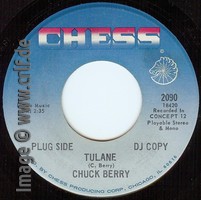
CHESS 2090 promo label
From 1970 onwards, no mono releases of new Berry material were ever produced or released; with one exception: In 1979 ATCO Records produced a DJ copy of Berry's new 45rpm single “
Oh What a Thrill b/w California” (ATCO 7203). And just like in 1970 the promotional single had the plug-side “Oh What a Thrill” on both sides, one in Stereo and one in Mono.
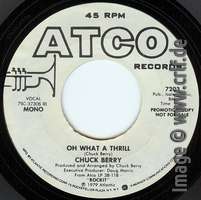
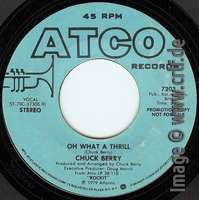
ATCO 7203 promo, mono and stereo side labels
Acknowledgements
Steve Hoffman was of great help during the research of this article both through the public explanations on his forum as well as by answering additional questions in email. Andy McKaie was so nice to check the text for correctness and provided some additional thoughts. Many thanks to both! Next, the author needs to (and really likes to) thank fellow researchers Morten Reff and Thierry Chanu for listening to songs such as “O Rangutang” and “Club Nitty Gritty” dozens of times in hunt for a true stereo version in their huge collections of Chuck Berry records as well as their additional help with variants and images. Finally huge thanks go to fellow researcher Arne Wolfswinkel for his technical expertise in analyzing released versions in search for the original session tape contents.
[addition 31-08-2023]
Within the 2019 text above I explained the ERS technique (“electronically reprocessed for stereo”) used for “Club Nitty Gritty” and many 1960s re-issues of older albums. Using this the original mono recording was modified to sound like a stereo recording even though such never existed.
Beginning in 2020 ERIC Records started to use a more modern technique to create the same. Using computer programs to separate the individual instruments in a mono recording (such as drums, piano or guitar) they digitally created individual tracks for these instruments and remixed those. This technique is known as DES (“digitally extracted stereo”,
https://www.ericrecords.com/des_explan-htf17.html). The result is much better than the 1960s ERS variants, but still it's a fake.
There never has been a stereo recording of e.g. Berry's original “Roll Over Beethoven” and there never will be one.
